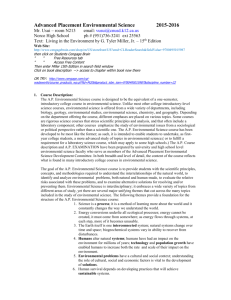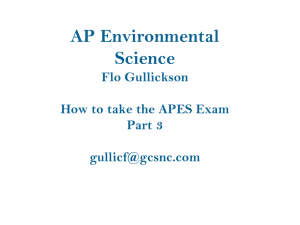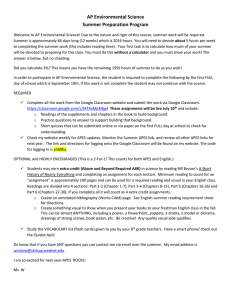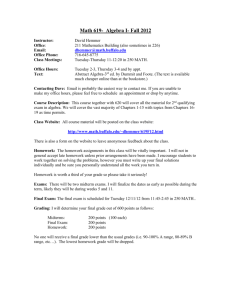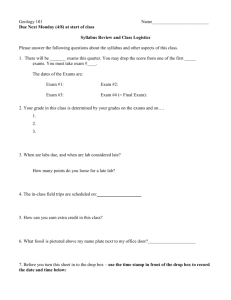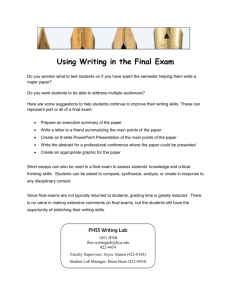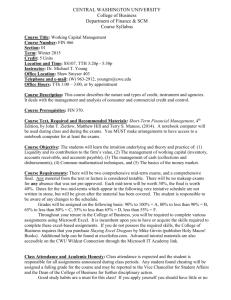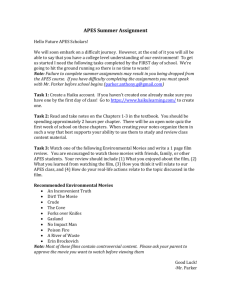Advanced Placement Environmental Science - Corona
advertisement
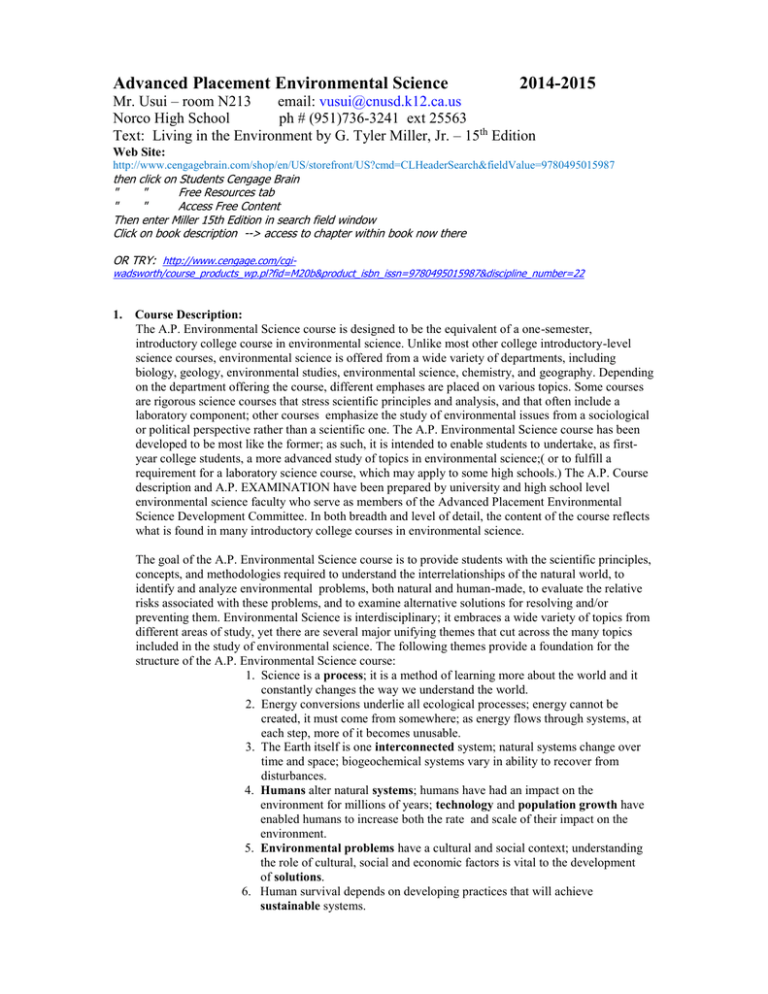
Advanced Placement Environmental Science 2014-2015 Mr. Usui – room N213 email: vusui@cnusd.k12.ca.us Norco High School ph # (951)736-3241 ext 25563 Text: Living in the Environment by G. Tyler Miller, Jr. – 15th Edition Web Site: http://www.cengagebrain.com/shop/en/US/storefront/US?cmd=CLHeaderSearch&fieldValue=9780495015987 then click on Students Cengage Brain " " Free Resources tab " " Access Free Content Then enter Miller 15th Edition in search field window Click on book description --> access to chapter within book now there OR TRY: http://www.cengage.com/cgi- wadsworth/course_products_wp.pl?fid=M20b&product_isbn_issn=9780495015987&discipline_number=22 1. Course Description: The A.P. Environmental Science course is designed to be the equivalent of a one-semester, introductory college course in environmental science. Unlike most other college introductory-level science courses, environmental science is offered from a wide variety of departments, including biology, geology, environmental studies, environmental science, chemistry, and geography. Depending on the department offering the course, different emphases are placed on various topics. Some courses are rigorous science courses that stress scientific principles and analysis, and that often include a laboratory component; other courses emphasize the study of environmental issues from a sociological or political perspective rather than a scientific one. The A.P. Environmental Science course has been developed to be most like the former; as such, it is intended to enable students to undertake, as firstyear college students, a more advanced study of topics in environmental science;( or to fulfill a requirement for a laboratory science course, which may apply to some high schools.) The A.P. Course description and A.P. EXAMINATION have been prepared by university and high school level environmental science faculty who serve as members of the Advanced Placement Environmental Science Development Committee. In both breadth and level of detail, the content of the course reflects what is found in many introductory college courses in environmental science. The goal of the A.P. Environmental Science course is to provide students with the scientific principles, concepts, and methodologies required to understand the interrelationships of the natural world, to identify and analyze environmental problems, both natural and human-made, to evaluate the relative risks associated with these problems, and to examine alternative solutions for resolving and/or preventing them. Environmental Science is interdisciplinary; it embraces a wide variety of topics from different areas of study, yet there are several major unifying themes that cut across the many topics included in the study of environmental science. The following themes provide a foundation for the structure of the A.P. Environmental Science course: 1. Science is a process; it is a method of learning more about the world and it constantly changes the way we understand the world. 2. Energy conversions underlie all ecological processes; energy cannot be created, it must come from somewhere; as energy flows through systems, at each step, more of it becomes unusable. 3. The Earth itself is one interconnected system; natural systems change over time and space; biogeochemical systems vary in ability to recover from disturbances. 4. Humans alter natural systems; humans have had an impact on the environment for millions of years; technology and population growth have enabled humans to increase both the rate and scale of their impact on the environment. 5. Environmental problems have a cultural and social context; understanding the role of cultural, social and economic factors is vital to the development of solutions. 6. Human survival depends on developing practices that will achieve sustainable systems. 2. Who is taking A.P. Environmental Science? The course is designed for interested students who have completed two years of high school laboratory science -one year of biology and one year of chemistry. Given this, A.P. Environmental Science is usually taken in either the junior or senior year. APES students, this course marks the eighth, ninth, tenth, etc. AP course which they have taken: for others, APES is the initial AP science course they have enrolled in and/ or the first AP course in any discipline which they have taken. The diversity of students in this course is one of the unique, and in my opinion, truly outstanding aspects of the AP Environmental Science course. 3. Outline of Topics: The following is an outline of major topics, which serves to define the scope of both the AP Environmental Science course and the AP Exam. The order of the topics in the outline holds no special significance, since there are many different sequences in which the topics can be approximately addressed in the course. The percentage after each major topic heading shows the approximate proportion of questions on the examination that pertain o that heading; thus the percentage also indicates the relative emphasis that will be placed on the topics in the course. Topic Miller Chapters A. Interdependence of Earth's Systems: Fundamental Principles and Concepts: (25%) 2 - 9, 10, 1. The flow of energy. 12, 13,14, 2. The cycling of matter. 15 3. The solid Earth; geologic time scale, earth dynamics. 4. The atmosphere. 5. The biosphere. B. Human Population Dynamics: (10%) 1. History and global distribution. 2. Carrying capacity. 3. Cultural and economic influences. 1, 2, 8, 9 23-26 C. Renewable and Nonrenewable Resources: distribution, ownership, use, degradation: (15%) 1. Water 2. Minerals 3. Soils 4. Biologic 5. Energy 6. Land 14-17, 19, 2 0,21,23 D. Environmental Quality: (20%-25%) 1. Air, water, Soil 2. Solid Wastes 3. Impact on Human Health 13, 14, 18-22 E. Global Changes and Their Consequences: (15%-20%) 1. 2. 3,9,11,25 First-order Effects: carbon dioxide, methane, stratospheric ozone in the atmosphere, ocean surface temperatures/ currents/ sea levels, habitat destruction/ loss of biodiversity/ introduced exotics. Higher-order Interactions: carbon dioxide and photosynthesis, ocean currents and climate/ biological communities, ultraviolet light and cell damage. F. Environment and society: trade off and decision making(5%) 1. Economic forces 2. Cultural and Aesthetic considerations 3. Environmental ethics 4. Environmental Laws and Regulations G. Choices for the Future (5%) 1. Conservation 2. Preservation 3. Restoration 4. Remediation 5. Mitigation 6. Sustainability 4. Laboratory experiments and Field investigations: Laboratory experiments and field investigations are designed to complement the "indoor classroom"/lecture -discussion portion of the course by providing opportunities to learn about our environment through firsthand observations, to test concepts and principles which have been introduced in class, to explore specific issues and problems in greater depth, and to gain an awareness of the importance of confounding variables which exist in the real world. Investigations will be diverse; examples include ecosystem dynamics, soil analysis, ecological succession, population studies, carrying capacity, energy consumption, field-testing for tropospheric ozone, air pollution, toxicity testing, water-quality testing, raising and releasing rainbow trout, urban-planning, solid waste management, and the greenhouse effect, to name just a few. These labs and many others will invite students to think critically, to observe environmental systems, to develop and conduct well designed experiments, to utilize appropriate techniques and instrumentation, to analyze and interpret data, including statistical and graphical presentations, to think analytically and apply concepts to the solution of environmental problems, to form conclusions and to evaluate their quality and validity, to propose further questions for study and to communicate accurately and meaningfully about observations and conclusions. Most lab and field investigations will be conducted in small groups, with each student being responsible for their own lab-write-up report. Lab handouts will be given to you prior to each lab; you are to write on YOUR lab-write-up unless otherwise stated. 5. Text Living in the Environment, 15th edition, G Tyler Miller, Jr., Copyright 2007, Brooks/Cole Thomson Publishing Company. ISBN 0-495-12551-2. Phone 1-800-423-0563 should you wish to purchase your own copy. List price is $100.00 with the CD-ROM…. (Cengage Books app may be available, and Hippocampus is also a useful site to use). Smartphone app link: http://deimos3.apple.com/DeliverEnclosure/cnx.org/pdfs/col105481.2.pdf?downloadKey=1368026691_50f539b0b4f4614c7033e767011dca36 6. The EXAM: Monday, May 4, 2015 – Morning session…8am Fee approx $89 It is my expectation that students enrolled in APES will take this exam…you will be successful. The AP Environmental Science Exam created by The College Board and The Education Testing Service, will be administered on May 4, 2015. This Exam is three hours in length and consists of two parts: a multiple-choice section comprised of 100 question and forming 60% of the grade, and a freeresponse section comprised of four questions and forming 40% of the grade. The multiple-choice section is designed to cover the breadth of your knowledge and understanding of environmental science and includes thought-provoking problems and questions based on fundamental ideas from environmental science as well as questions based on the recall of basic facts and major concepts. The number of multiple-choice questions taken from each major topic area is reflected in the percentage of the course as designed in the outline of topics. The free-response section response section emphasizes the application of principles in greater depth; you will need to organize answers to organize answers to broad questions, demonstrating reasoning and analytical skills, as well as the ability to synthesize material from several sources in to cogent and coherent essays. There are three types of free-response questions; (1)data-analysis, (2)document-based, and (3)synthesis and evaluation free-response questions. The data-analysis/calculation-based/lab-based question provides you with one or more data sets, or calculation-based questions, or a laboratory-design type of scenario, and you are asked to manipulate, analyze, and interpret data, or design an experiment; the document-based question(s) present you with a news article, a product advertisement, a pamphlet, or another similar document, and your task is to apply knowledge of environmental science to contexts that are timely, relevant, and authentic(information in the document must be used); the synthesis/evaluation questions are in-depth, often multi-part essay questions that require you to synthesize and evaluate ideas by using concepts of environmental science. 7. Grading: Based on total points earned. Exams: chapter/topic exams over 1 or more chapters (approx. 100-200 points each) Quizzes: announced and unannounced (generally10, 20, 30 points each) – ex: Env Laws Laboratory/Field reports/Write-ups: (approx. 50-100 points each) Homework assignments: question/problem sets, and other written work. Chapter Objectives, FRQ’s, vocabulary: (approx. 50 points each) do not put these off!! Participation in class: class discussions, sharing pertinent and relevant experiences Other assignments/projects: Science Fair Project*, scrAPEbook, videos, case/impact studies, etc. Quarter exams: given end of 1st quarter and 3rd quarter…these exams are cumulative Semester exam: Sem I Final Exam is cumulative: December 2014 Pre-AP Exam: approx April 9-10 and April 16-17, 2015 Post-AP work and Laboratory Exams will generally be given at the end of each chapter(s); exams will generally have 40-70 multiplechoice questions and two free-response questions. Exams will occasionally be given over two/more chapters. You will be responsible for course material from throughout the course on every exam; that is to say that the "connections", common themes, and interrelationships are numerous in this course. You are encouraged to take notes on class readings assignments from the text and other sources, and to keep theses notes for the duration of the course to serve as a study guide for the May APES EXAM. You may also see matching and fill-in the blank questions on a few of the exams to add a bit of variety to our lives. Chapter exams and quizzes will comprise 65-70% of the total points, with the remaining points coming from class assignments. Letter grades are determined by a fairly traditional scale : 90-100 = A, 80-89= B, 6579= C, 55-64= D, 54-0= F. Various forms of extra credit available-extra credit doesn’t replace missed work. Missing an exam: You should be prepared to take a missed exam on the day you return to school, if your absence is excused; if it is not excused, no points will be earned. The exams given to students who missed the original exam may be different in style and format; e.g., the make-up exam may be all fill in the blank, with no term list. Before school, lunch, afterschool (by appt only) are the available times for make-ups. A Science Project, and all its component parts can be done in place of other projects. 8. Materials you should have for APES: You should have a notebook for class notes, which you have taken both in class, during lecture-discussion lessons and while reading the text; a three-ring binder is recommended, so that filing/organizing course handouts and other information (labs, objectives, frq’s, vocabulary, etc…) is that much easier. In addition, you will be asked periodically to bring specific items; examples include clear plastic soda bottles, soil samples, a guppy or aquatic snail, fish food, plastic cups, an aquatic plant, terrestrial plants, cut grass, seeds, cardboard, a camera/film, and various foods, to name a few items. Expectations/Noteworthy Qualities: As previously stated, students enrolled in APES are expected to take the May AP Environmental Science Exam. Be prompt, prepared, polite, and courteous to those around you; "save the gum”, granola, Powerbars, fresh fruit, bagels, Starbuck's coffee, Grape-nuts, etc. for a time and setting when more quality attention can be given to these and other food and drink items; no late work is accepted; give your penguin a jacket, -- preserve your book for future generations. "Other Stuff" which you (already) should know. *be on time (worth repeating) walking in late without a really good reason (you might be able to think of a few really poor reasons) will mean the loss of 10 points per unexcused tardy and possibly the loss of pop-quiz points (should there be one on the day(s) that you decide to arrive late), *have the materials needed for class with you in class, *restroom requests are the exception, not the rule or the norm---thank you in advance for not making a habit of asking to go visit the restroom/drinking fountain/vendingland/counselors office/lockers/car/truck/SUV/yak/student store/Etc. *"What are we doing today in APES?" most of the time, you should not need to ask this question: be prepared by reading the “weekly plan" on the board. It is your responsibility to find out what has been missed, and to arrange a time for make-up. If you are to be gone from class for an activity (band, choir, ASB, etc…) it is your responsibility to complete, and turn in, the assignment/lab/project prior to the day of absence. . *Be in class on exam days; failure to do so may result in a zero on that exam. *Help prevent the tragedy of the commons...thank you for finding the recycle bins and the "trash" cans. Additional expectations: Read the textbook assigned readings . (Past students who have scored well on chapter tests have thoroughly read each chapter!!), cover your book, be attentive, be polite, be responsible, be interested in/open to the field of environmental science, have materials, listen to others, be neat, participate in class discussions, and class projects, labs, and field work, to pay attention to class videos and class presentations from your colleagues, guest speakers, and by me, to not work on other class work (your calculus, history/gov’t, english, physics, spanish, etc.) during APES, to do your own work/deal with any "urge" to look at a neighbors exam during a test by being honest and doing your own work Do your part, and you will succeed. If you help each other throughout the year (completing your chapter objectives and frq’s, vocabulary) you will help each other to succeed in everything we do. The May Exam is one part of this course…it is not the end. Your consistent interest, involvement, focus, and efforts in this course will put you in fine position for doing a superb job on the May AP Exam. You will help each other be successful on the EXAM. HOPE THE 2014-2015 SCHOOL YEAR IS A SUPERB ONE FOR YOU!! MAHALO and NAMASTE, MR. USUI “Be the change you wish to see in the world” M. Gandhi In addition to the textbook, it is advised that you purchase one of the APES references books that are out. I would suggest the Barron’s –or- 5 Steps to a 5. This is a tentative schedule for Chapter exams between August 12 and April 23; Each chapter may have an exam (some chapters may be combined into one exam); there will be a 1 st quarter exam, a semester I exam, a 3rd quarter exam (all of which are comprehensive), and a Pre-AP final exams prior to the AP Environmental Science Exam on 5/05/14. Tentative Exam Dates: Metric conversions and ecology calculations Aug. 15 Exam 1 Chapters 1, 2 Aug. 14 Science Project Exam 2 Chapters 24, 25 Aug. 22 Exam 3 Chapter 3 Aug. 29 Exam 4 Chapter 5, 6 Sept. 11 Exam 5 Chapters 4, 7 Sept. 25 First Cummulative Exam??? Oct 6 Exam 6 Chapter 10-12 Oct. 22 Exam 7 Chapter 18 Nov. 1 Exam 8 Chapter 14, 21 Dec. 5 Complete science project exp. Exam 9 Chapter 8, 9 Dec. 12 and data collection Second Cummulative Exam??? Dec. tba Exam 10 Chapter 22, 23 Jan. 21 Third Cummulative Exam??? Jan. 28 Exam 11 Chapter 15 - 17 Feb. 19 Exam 12 Chapter 13 March 6 Exam 13 Chapter 19, 20 March 20 PRACTICE TEST #1 April PRACTICE TEST #2 April APES Test Exam Prep March – May 4 (meet early am May 4) Semester II FINAL- Cummulative May 18-19, 2015 (Cumulative and 4 FRQ’s) - Plus other material from throughout the course/school year SEM II FINAL is REQUIRED for those who did not take the AP exam
